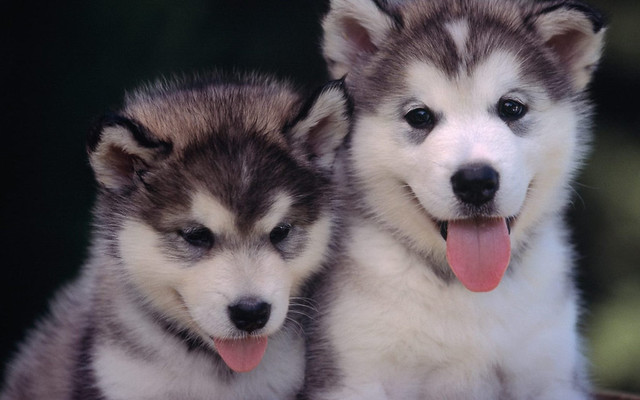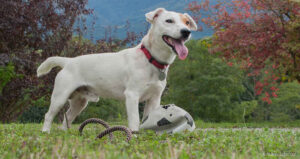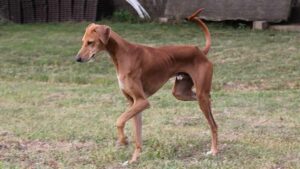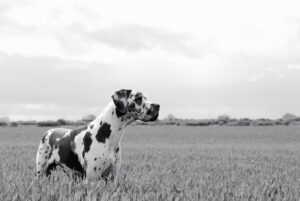The Alaskan Malamute’s origins can be traced back thousands of years to the native Inuit people of Alaska, who bred them as sled dogs and companions. Named after the Mahlemiut tribe, the Alaskan Malamute played a crucial role in Arctic expeditions and transportation. They were recognized by the American Kennel Club (AKC) in 1935 and have since become popular as both working dogs and family pets.
Alaskan Malamute at a glance
| Attribute | Description |
|---|---|
| Temperament | Friendly, affectionate, independent |
| Social | Sociable with people and other animals, may be protective |
| Training | Requires patience and consistency |
| Grooming | Regular brushing and grooming, heavy shedding twice a year |
| Care | Regular exercise, attention to diet and healthcare needs |
| Physical Traits | Large and powerful, thick double coat, erect ears |
| Adaptability | Adaptable to various living environments, requires |

Temperament: Alaskan Malamutes are known for their friendly and affectionate temperament. They are gentle giants, often described as loyal and devoted companions to their families. While they possess a playful and mischievous streak, they are also dignified and independent. They are typically good-natured dogs but require consistent training and socialization from an early age to ensure they develop into well-mannered adults.
Social: When properly socialized, Alaskan Malamutes can be friendly and sociable with people and other animals. They enjoy the company of their family members and may be protective of them. However, their strong prey drive and pack instincts mean they may not always get along with small pets, so supervision is recommended. Early socialization helps ensure they interact positively with others.
Training: Training an Alaskan Malamute requires patience, consistency, and positive reinforcement techniques. They are intelligent dogs but can be independent and stubborn, so firm yet gentle leadership is essential. Early obedience training and socialization are crucial to channel their energy and prevent behavioral issues. They are quite large and very strong, and they tend to approach training a little differently than other dog breeds.They hate drilling and repetitive work and can get bored very quickly.
Grooming: Alaskan Malamutes have a thick double coat that requires regular grooming to keep it in optimal condition. They shed heavily twice a year, known as blowing their coat, during which more frequent brushing is necessary to remove loose hair and prevent matting. Regular grooming also includes nail trims, ear cleaning, and dental care to maintain their overall health and well-being.

Care: Alaskan Malamutes thrive in homes where they receive plenty of mental and physical stimulation. They require regular exercise to keep them happy and healthy, including daily walks, playtime, and opportunities to explore. Attention to their diet, healthcare needs, and regular vet check-ups are essential for their overall well-being.
Physical Traits: The Alaskan Malamute is a large and powerful breed with a sturdy and well-muscled build. They have a broad head, erect ears, and a plumed tail carried over their back. It is similar in appearance to other spitz breeds like the Siberian husky and the Alaskan klee kai. Their thick double coat comes in various colors, including shades of gray, black, and sable. Alaskan Malamutes have a dignified and imposing presence, reflecting their heritage as working sled dogs.
Adaptability: Alaskan Malamutes are adaptable dogs that can thrive in various living environments, including apartments and houses. However, they require ample space to move around and regular exercise to prevent boredom and destructive behaviors. They are best suited to homes with a securely fenced yard where they can safely explore and play.
Nutrition: A balanced diet is essential for the health and vitality of Alaskan Malamutes. High-quality dog food formulated for large breeds is recommended, with consideration for their size, age, and activity level. Portion control is important to prevent obesity, as Alaskan Malamutes can be prone to weight gain if overfed. Fresh water should always be available for hydration.
Quick Facts:
- Alaskan Malamutes are one of the oldest Arctic sled dog breeds, with a history dating back thousands of years.
- They are named after the native Mahlemiut tribe of Alaska, who bred them for hauling heavy loads and sledding.
- Alaskan Malamutes have a strong prey drive and may not always get along with small pets, so supervision is recommended.
- They are known for their endurance and strength, capable of pulling heavy loads over long distances.
- Despite their imposing size, Alaskan Malamutes are known for their friendly and affectionate nature towards their families.
Alaskan Malamute as Pets
Alaskan Malamutes can make wonderful pets for experienced owners who understand their unique needs. As loyal and affectionate companions, they thrive in environments where they receive ample exercise and mental stimulation. Their playful nature and strong pack instincts make them excellent family dogs, but their large size and high energy levels require a dedicated owner who can provide consistent training and socialization. With proper care and attention, an Alaskan Malamute can be a loving and devoted member of the family.

Alaskan Malamute Price
The price of an Alaskan Malamute can vary depending on several factors such as the breeder’s reputation, lineage, location, and the individual puppy’s characteristics. On average, expect to pay between $1,000 to $2,500 for a pet-quality Alaskan Malamute puppy from a reputable breeder. Show-quality or champion bloodlines may command higher prices, ranging from $2,500 to $6,000 or more. Additionally, factors such as coat color, markings, and eye color can influence the puppy’s price. It’s crucial to do thorough research and choose a responsible breeder who prioritizes the health and well-being of their dogs. Adopting from shelters or rescue organizations is another option, typically costing less and providing a loving home to a dog in need.
FAQ about Alaskan Malamute
- Can an Alaskan Malamute lure course? – While they can participate in lure coursing, they are not the best for this sport.Compared to other traditional lure coursing dog breeds like greyhounds or whippet, they are quite large and very strong and gets bored easily.
- Are Alaskan Malamutes good with children? – Alaskan Malamutes can be excellent family dogs when properly trained and socialized from a young age. They are known for their gentle and affectionate nature towards children, but supervision is recommended due to their large size and strength.
- Do Alaskan Malamutes shed a lot? – Yes, Alaskan Malamutes shed heavily, particularly during shedding season when they “blow” their coat. Regular grooming and brushing are necessary to manage shedding and keep their coat healthy.
- How much exercise do Alaskan Malamutes need? – Alaskan Malamutes are energetic dogs that require ample exercise to stay physically and mentally stimulated. Daily walks, playtime, and opportunities for outdoor activities are essential to meet their exercise needs.
- Do Alaskan Malamutes get along with other pets? – With proper socialization, Alaskan Malamutes can coexist well with other pets in the household. However, their strong prey drive may make them inclined to chase smaller animals, so early socialization and supervision are recommended




